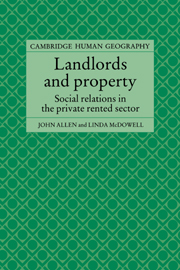Book contents
- Frontmatter
- Contents
- List of figures and tables
- Preface
- 1 Introduction
- 2 Private landlords: the anatomy of uneven decline
- 3 The structure of private landlordism
- 4 Research design and methods
- 5 Landlords in profile: an intensive survey
- 6 Landlords in the inner city: an extensive survey
- 7 Political ideologies and private rental policies
- Policy postscript
- Appendix 1 Selecting the landlord sample from housing waiting list records
- Appendix 2 Who was rehoused?
- References
- Index
1 - Introduction
Published online by Cambridge University Press: 17 September 2009
- Frontmatter
- Contents
- List of figures and tables
- Preface
- 1 Introduction
- 2 Private landlords: the anatomy of uneven decline
- 3 The structure of private landlordism
- 4 Research design and methods
- 5 Landlords in profile: an intensive survey
- 6 Landlords in the inner city: an extensive survey
- 7 Political ideologies and private rental policies
- Policy postscript
- Appendix 1 Selecting the landlord sample from housing waiting list records
- Appendix 2 Who was rehoused?
- References
- Index
Summary
The background to the research reported here is located in two General Elections in Britain, 1964 and 1979. In the 1964 election, housing assumed a central political role, which indirectly can be traced to the activities of one west London private landlord named Rachman. Interest in Rachman was the by-product of the Profumo Affair, a ministerial sex scandal, which rocked the Conservative Government and led to its downfall in 1964 (see Green, 1979). Rachman and his rent collectors provided the key issue over which the 1964 election was fought: the poor physical condition of the housing stock, the absolute need for housing and the necessity for the state to intervene in housing to remove the worst excesses of the private provision of housing. In the early 1960s, private rented housing comprised approximately one-third of the housing stock in England and Wales, and in urban areas such as Greater London the majority of households were private tenants. At that time, private rented housing provision was a significant political issue.
It was not until 1979 that housing reappeared as a crucial election issue, but in the context of a radically new debate and a new set of policy issues. The focus of the debate over housing was no longer the problem of supply, the condition of the housing stock, but rather one of demand, the problem of tenure.
- Type
- Chapter
- Information
- Landlords and PropertySocial Relations in the Private Rented Sector, pp. 1 - 11Publisher: Cambridge University PressPrint publication year: 1989



